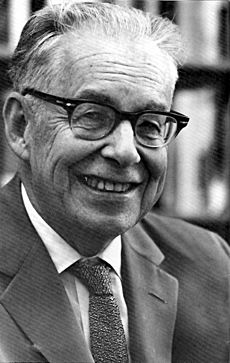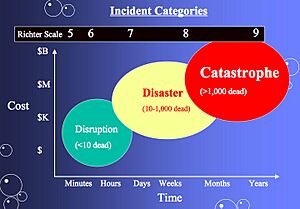Richter scale facts for kids

The Richter magnitude scale is a special way to measure how big an earthquake is. Imagine a ruler for earthquakes! Charles Richter created this scale in 1935. He designed it using information from a machine called a seismometer. This machine records ground shaking, and Richter's scale used measurements taken 100 kilometers (about 62 miles) away from an earthquake.
Even small earthquakes, like those 4.5 or higher on the Richter scale, can be detected by special tools all around the world.
The Richter scale works in a special way called "logarithmic." This means that each whole number step on the scale is much bigger than the last. For example, an earthquake that measures 3.0 is about 10 times stronger in shaking than one that measures 2.0. The energy released by the earthquake also increases a lot, by about 32 times for each whole number step!
How Earthquakes Are Measured
The Richter scale helps us understand the power of an earthquake. Here's what different numbers on the scale mean for damage and how often they happen:
| What it's called | Richter Scale Number | Damage Caused | How Often it Happens |
|---|---|---|---|
| Micro | Less than 2.0 | These earthquakes are very small. People cannot feel them at all. | About 8,000 times every day |
| Very Minor | 2.0-2.9 | People usually don't feel these. But special machines called seismographs can detect them. | About 1,000 times per day |
| Minor | 3.0-3.9 | People often feel these small shakes. They almost never cause any damage. | About 49,000 times each year |
| Light | 4.0-4.9 |
Things inside houses might shake and make noise. It's rare for anything to get damaged. |
About 6,200 times each year |
| Moderate | 5.0-5.9 |
Buildings that are not built very strong might get damaged. Light objects inside a house could move around. |
About 800 times per year |
| Strong | 6.0-6.9 |
These are quite powerful. They can cause a lot of damage in a larger area. |
About 120 times per year |
| Major | 7.0-7.9 | These can cause serious damage over very large areas. | About 18 times per year |
| Great | 8.0-9.9 | These cause massive damage. Heavy things can be thrown into the air. Cracks appear on the ground, and you might even see shockwaves. Highways can be destroyed, and buildings fall down. | About 1 time every 20 years |
| Meteoric | 10.0+ | No earthquake of this size has ever been recorded. The shaking would be like a huge meteor hitting Earth. | Unknown |
(Information adapted from U.S. Geological Survey documents)
The biggest earthquake ever recorded was the Great Chilean Earthquake. It happened in 1960 and measured about 9.5 on the Richter scale. Sadly, about 6,000 people died because of this powerful earthquake.
Comparing Earthquakes to Explosions
To help understand how much energy an earthquake releases, we can compare it to the energy from TNT explosions.
| Richter Scale Number | Energy Like (TNT) | Example Event |
|---|---|---|
| 0.5 | 5.6 kilograms | A large hand grenade |
| 1.5 | 178 kilograms | A Bomb used in WWII |
| 2 | 1 metric ton | A large bomb used in WWII |
| 2.5 | 5.6 metric tons | A Blockbuster bomb (dropped from airplanes) in WWII |
| 3.5 | 178 metric tons | The Chernobyl accident in 1986 |
| 4 | 1 kiloton | A small atomic bomb |
| 5 | 32 kilotons | The Nagasaki atomic bomb The Lincolnshire earthquake (UK) in 2008 |
| 5.4 | 150 kilotons | The 2008 Chino Hills earthquake (Los Angeles, USA) |
| 5.5 | 178 kilotons | Little Skull Mtn. earthquake (NV, USA), 1992 The Alum Rock earthquake (CA, USA) in 2007 |
| 6.0 | 1 megaton | Double Spring Flat earthquake (NV, USA), 1994 |
| 6.5 | 5.6 megatons | Caracas (Venezuela) in 1967 Rhodes (Greece) in 2008 The Eureka Earthquake (Humboldt County CA, USA) in 2010 |
| 6.7 | 16.2 megatons | The Northridge earthquake (CA, USA) in 1994 |
| 6.9 | 26.8 megatons | The San Francisco Bay Area earthquake (CA, USA) in 1989 |
| 7.0 | 32 megatons | The Java earthquake (Indonesia) in 2009, the 2010 Haiti Earthquake |
| 7.1 | 50 megatons | Energy like the Tsar Bomba, the largest nuclear weapon ever tested The 1944 San Juan earthquake |
| 7.5 | 178 megatons | The Kashmir earthquake (Pakistan) in 2005 The Antofagasta earthquake (Chile) in 2007 |
| 7.8 | 600 megatons | The Tangshan earthquake (China) in 1976 North Canterbury (New Zealand) in 2016 |
| 8.0 | 1 gigaton | The San Francisco earthquake (CA, USA) in 1906 The Queen Charlotte earthquake (BC, Canada) in 1949 The México City earthquake (Mexico) in 1985 The Gujarat earthquake (India) in 2001 The Chincha Alta earthquake (Peru) in 2007 The Sichuan earthquake (China) in 2008 (first thought to be 7.8) The 1894 San Juan earthquake |
| 8.5 | 5.6 gigatons | The Toba volcanic eruption 75,000 years ago; the largest known volcanic event. The Sumatra earthquake (Indonesia) in 2007 |
| 9.0 | 32 gigatons | The 2011 Sendai, Japan Earthquake and Tsunami The Lisbon Earthquake (Lisbon, Portugal) on All Saints Day, 1755 |
| 9.1 | 67 gigatons | The Indian Ocean earthquake in 2004 |
| 9.2 | 90.7 gigatons | The Anchorage earthquake (AK, USA) in 1964 |
| 9.5 | 178 gigatons | The Valdivia earthquake (Chile) in 1960 |
| 13.0 | 100 teratons | The impact that caused the Chicxulub crater in the Yucatán Peninsula 65 million years ago. |
Other pages
See also
 In Spanish: Escala sismológica de Richter para niños
In Spanish: Escala sismológica de Richter para niños


